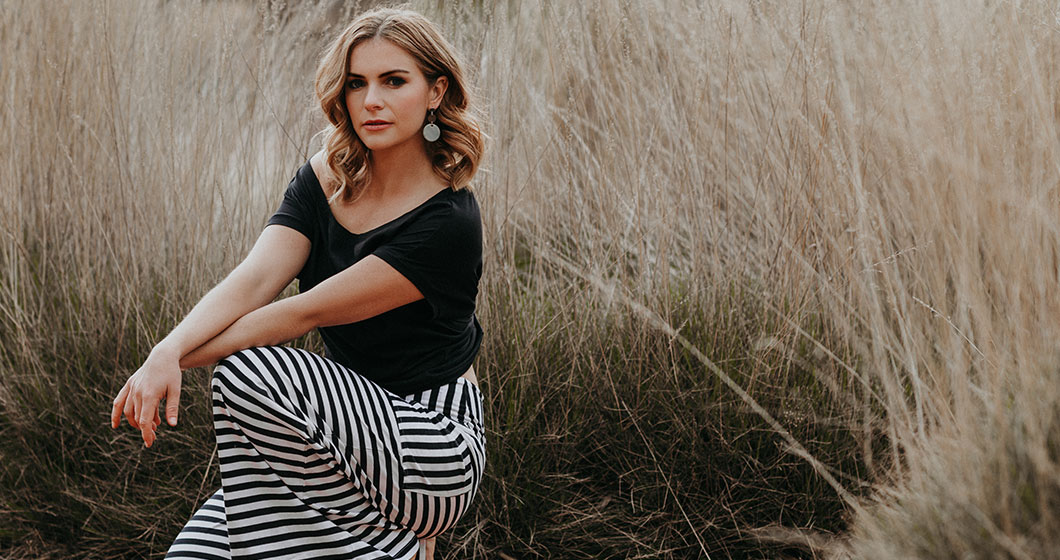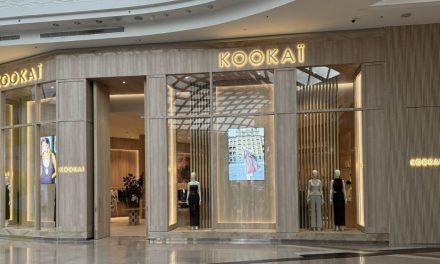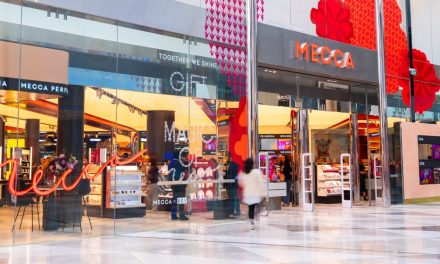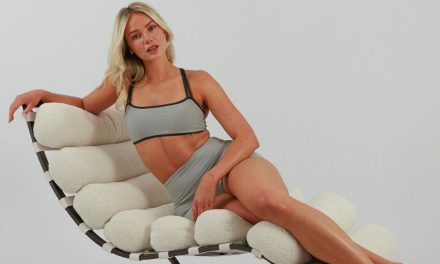In a world of fast-fashion, Canberra born designer Kelli Donovan merges innovation and eco-friendly designs to produce her latest collection – Native Pollen.
Held in Pollinator Week—Kelli, launches her new designs for Pure Pod and will feature inspirational guest speakers, to discuss the direct relationship between the environment and the clothing supply chain, Saturday 17 November 6-8.30pm at Jindii Eco Spa, Acton.
To get a better understanding of the ethos behind Pure Pod we sit down with Kelli to discuss her passion to create a cleaner fashion industry.
What made you decide to be an ethically conscious brand?
After working in the main stream fashion industry for many years I saw the devastating impact fashion manufacturing has on the people working in it and on our environment. I needed to find a connection with my creative career and the environment and it just felt natural to do my own ethical and sustainable label – Pure Pod.
How did this impact Pure Pod’s core values?
Back in 2007 when we started, Pure Pod in Byron Bay, our main passion was mostly about the environmental impact clothing has on soil, air and water resources. Now with the massive over supply of fast fashion and it’s huge problems with modern day slaves around the globe and enormous over use of natural resources our business decisions look at all of our foot print. The clothing industry is one of the highest polluting industries in the world.
We needed to be part of the solution not part of the problem and we wanted to be pioneers in our trade. I couldn’t design for polluting industries that don’t feel they have any negative impact and only look at the dollar and don’t care who, why or how their clothing is made.
How have your values impacted the culture of your business?
The environment and people involved are the most important assets in our business and they impact every aspect of the main culture of our Pure Pod business. We try to look at our whole supply chain and how our clothing impacts this. We look at the garment right from the seed through to the end life cycle of the garment. We choose fabrics and trims with all of this in mind. As a small business with limited assets we try to do as much as we can but there is always something around the corner that we can change to make our systems better.
And the people it attracts?
With these values it attracts customers who want well made clothing and purchases that have a positive impact. Women are often sick of buying cheap and badly made clothing that doesn’t last. Fast fashion has lost the connection and wonderful story between the makers and the end supply to the consumer. By designing and producing Pure Pod we are providing this product again to consumers who want to know their money is making a positive impact to the industry and the environment. Everyone wears clothing, you don’t have to be a hippy or greenie to care about how long your clothing lasts, who is making it and what it is made from. We all need to take care of our natural resources and lower the impact of our purchases and wear our clothing for longer.
Why did you decide to make Canberra your base?
I grew up in Canberra and went to the CIT to study fashion. I travelled around the world for the fashion industry while living and working in Melbourne, , worked in London and then Byron Bay to study yoga teaching after being totally disenchanted with my industry. We lived in the Byron area for 8 years, then moved back home for family reasons mostly, and we love it here. The bush capital is a wonderful place to live in and we are more closely connected to important Government bodies and other creatives.
Do you think there is a market here for ethically sourced goods? And who is your target audience?
Yes, of course, that is why we make these products. As the fast fashion industry grows at an unsustainable speed taking resources and creating huge problems, sustainable design will be the only way these industries can go. The consumer is demanding more authenticity of products and open supply chains. Consumers are more educated than ever about what they are buying, not everyone is in to this kind of purchase but as activists, like us, start to help change the industry, this will slowly become the norm in manufacturing.
This launch event is all about native pollinators and bees, why should people be concerned about the welfare of bees?
Bees are the main pollinators of our food and textile pollination without them many things we take for granted could be lost.
Our latest blog post from Summer Edwards – She writes – “We should be very worried about what is happening to the bees- honey bees and native- because, quite simply, we need them more than they need us. Bees are responsible for pollinating around one third of our food supply and up to 90% of wild plants, as well as increasing yields in many of our other plant based crops, including textile crops and also livestock crops such as alfalfa, which are used to feed the animals raised for meat consumption.”
We are collaborating with two impressive Canberra land marks – The Australian National Botanic Gardens during their ‘Pollinator Week’ and ‘Jindi Eco Spa.’ Both of these business have a similar passion for the environment and looking after people’s health and wellbeing. Without a healthy planet how can we have healthy people? This collaboration makes our voices louder and stronger to the public.
What bee-friendly fashion options are there in the market?
Choosing Bee-Friendly Fashion – a snippet from Summer Edward’s Pure Pod blog article:
Bee-friendly fashion is clothing made from textiles that have a minimal impact on bee populations. Hemp is a very bee-friendly textile. It is a hardy crop that naturally controls weeds and pests, so it does not require pesticides. Linen is another bee friendly textile, which has minimal use for pesticides and is a good food source for bees.
When it comes to bee health, choosing organic cotton is really the only way to ensure that bees are not exposed to pesticides. We choose organic cotton for our collections, for a number of sustainability reasons including to protect the bees.
Other bee friendly textiles include animal based textiles. Wool, for example, does use pesticides, but only as a direct application on the sheep to kill of parasites.
So in summary, your bee-friendly fashion options are:
- Hemp
- Linen
- Organic Cotton
- Wool
- Silk.
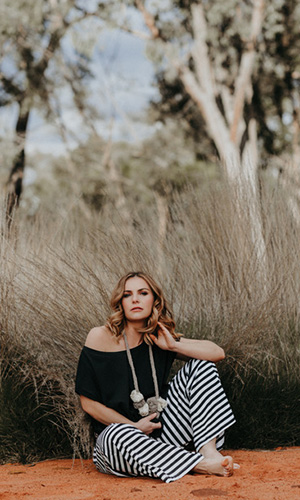
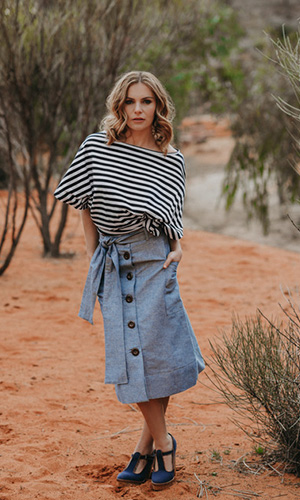
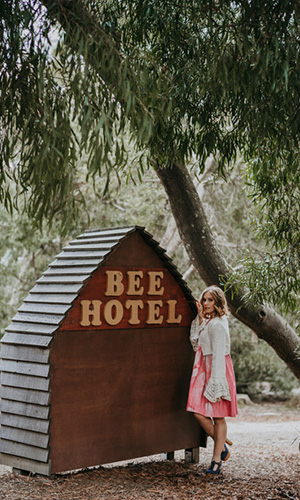
Photographer – Lauren Campbell; Model – Maree Lowes; Hair – Sass Hair Design; Make up – Liz Bomben; Assistant – Sarah Hudson; Collaborating textile artist – Bursaria Workshop – Abby French; Behind the scenes film – Tracy Lee Photography; Accessories – Woodfolk – Natural Accessories, Wild – The Lifestyle Companies; Location – The Australian National Botanic Gardens.
What advice would you give consumers who want to be more ethically conscious in their buying behaviour?
Buy what you need. Don’t over buy cheap products that you don’t think you will use for a long time. Buy quality, buy what you really love. Don’t buy clothing for one or two wears—repair, recycle and look after your clothing.
What does FLO & GOTS Certified clothes mean?
FLOCert (stylised as FLOCERT) ensures that producers and traders comply with the FLO International Fairtrade Standards, that traders pay the Fairtrade Premium to producers and that producers invest the benefits received through Fairtrade in their development.
The Global Organic Textile Standard (GOTS) is the worldwide leading textile processing standard for organic fibres, including ecological and social criteria, backed up by independent certification of the entire textile supply chain. The aim of the standard is to define world-wide recognized requirements that ensure organic status of textiles, from harvesting of the raw materials, through environmentally and socially responsible manufacturing up to labelling in order to provide a credible assurance to the end consumer.
If you had a chance to work with any designer who would you love to collaborate with?
Katherine Hamnett or Vivian Westwood or Orsola De Castro – the founder of Fashion Revolution Day – they are the real pioneers in this fashion activist movement. They are my gurus of change.
What was the biggest rookie mistake you made when starting Pure Pod
I think it is always cash flow in the fashion industry. It is hard even for large companies to access and prepare for costs in production and problems. I often see new talented designers get bogged down by the huge costs of this industry and give up. You have to be very driven and have a thick skin in this industry!
What is the biggest lesson that you have learned since you started Pure Pod?
My endurance and passion that keeps me going and connecting with the whole supply chain on a more human level. It’s not just about making clothing for me but the whole human story from the farmers to the cutters and makers and then to the consumers who wear Pure Pod. Every part of it has a human touch. Without a healthy environment and creative designers leading the way in sustainable design, this human touch will be affected.
What is your vision for the world?
As a sustainable designer and ethical fashion activist, I’d love to see all levels of manufacturing, agriculture and government look at implementing positive changes for all industries to ensure we have a clean healthy planet for future generations. We all are consumers and we all have a choice, it is not a hippy thing anymore, it is an educated choice now how we chose to consume, produce and recycle.


